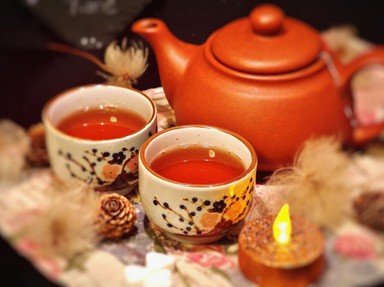Quiz Answer Key and Fun Facts
1. Tea made its way from Asia to Europe via the Dutch East India Company in the early 17th century. First it was a novelty, then a luxury item, and it finally became widely available and affordable during which British monarch's reign?
2. To drink tea, one must first brew tea, and there are long-standing disputes about the best way to do so. Traditionally tea is brewed in a teapot from loose tea leaves, but an invention in the early 20th century revolutionized the brewing of tea forever. What was this invention?
3. Tea is an essential part of many morning routines, but afternoon tea is an important social custom that can be highly ritualized. What food would not typically be seen at a traditional afternoon tea?
4. Another important ritual of afternoon tea concerns how the tea is served. At a formal tea, one person is responsible for pouring the tea into cups and adding whatever each drinker likes in their tea (such as cream or sugar). This is typically the privilege of the host or hostess. What affectionate nickname is sometimes applied to the person who pours out the tea?
5. When famous physicist Richard Feynman first arrived at Princeton University as a graduate student, he had little experience with formal events. At an introductory tea with the Dean, the Dean's wife asked whether he would like cream or lemon in his tea, to which the nervous Feynman replied that he would have both. According to Feynman, the Dean's wife responded "Heh-heh-heh-heh-heh. Surely you're joking, Mr. Feynman."
Why did the Dean's wife find Feynman's response so amusing?
6. Speaking of what we add to tea, what occupational nickname is associated with a very strong cup of tea with lashings of milk and sugar? (Construction is thirsty work!)
7. Still on the topic of what we add to tea, there is a longstanding debate about whether you put milk in the cup first and then pour in the tea, or add the milk after the tea is poured into the cup. What English author, famous for the dystopian novel "1984," expressed a strong preference for tea first, milk second?
8. Teapots can be made from many different materials including porcelain, glass, stoneware, stainless steel, and silver. Some are rough and ready and some are precious heirlooms.
A teapot that was a favorite of Victorians (and is still made today) was made from a particular red clay, cast in a characteristic round shape, and glazed with Rockingham glaze. This teapot's name is also the name of a baked fruit dessert. What is it called?
9. One unusual component of a old-fashioned tea set is a slop bowl. What was this item used for?
10. Now that teatime is over, we have to dispose of the spent tea leaves or teabags. What should we do with them?
Source: Author
SatchelPooch
This quiz was reviewed by FunTrivia editor
jmorrow before going online.
Any errors found in FunTrivia content are routinely corrected through our feedback system.
